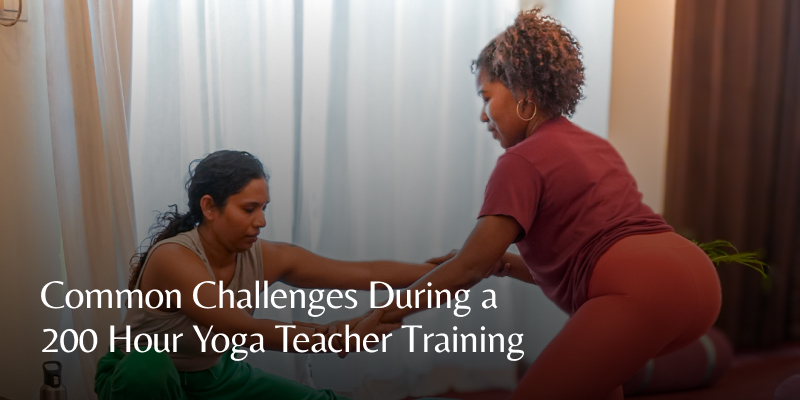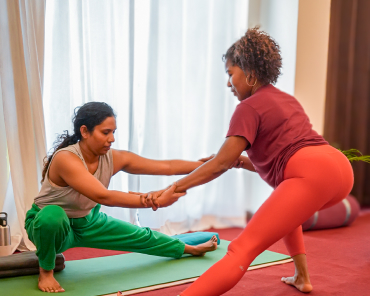
Introduction
Starting a 200 Hour Yoga Teacher Training (YTT) is a big leap—and a beautiful one. Whether you’re stepping in to deepen your personal practice or to become a certified teacher, you’ll soon find that YTT is more than just learning poses. It’s an intensive, transformative experience that works on your body, mind, and spirit.
But let’s not sugarcoat it—it also comes with challenges. And that’s completely okay. Growth never happens in comfort zones.
In this blog, I want to walk you through some common challenges that show up during YTT—and more importantly, how you can handle them with awareness and grace.
What is a 200 Hour Yoga Teacher Training Course?
A 200 Hour YTT is your foundational step into the world of yoga teaching. Most courses are 3 to 4 weeks long if done intensively, or can be spread over months. You’ll dive into yoga asanas, pranayama (breathwork), meditation, anatomy, yogic philosophy, teaching methodology, and more.
You’ll grow on every level—mentally, physically, emotionally—and that’s where the real work begins.
Common Challenges Faced During YTT
Physical Fatigue and Soreness
Expect your body to ache, especially in the first week. Daily asana practice (sometimes twice a day!) pushes your limits—even if you’re already fit.
How to handle it:
- Listen to your body. It’s okay to modify poses or take rest.
- Stay hydrated and stretch gently before bed.
- Don’t compare your flexibility to others—yoga is not a competition.
Read More: Why Is Kundalini Yoga Dangerous? The Truth About Its Risks and Rewards
Mental and Emotional Overwhelm
Along with physical intensity, YTT can stir up emotions. Long days, deep topics, and spiritual work often bring buried feelings to the surface.
How to handle it:
- Give yourself space to feel. Cry if needed. Journal often.
- Share with someone you trust—your teachers or fellow trainees.
- Understand that emotional release is part of healing.
Information Overload
You’re learning A LOT: anatomy terms, philosophy, Sanskrit names, cueing techniques… it’s easy to feel flooded.
How to handle it:
- Don’t try to memorize everything. Focus on understanding the key concepts.
- Use tools like voice notes, mind maps, or color-coded notes.
- Trust that repetition and practice will help things settle naturally.
Self-Doubt and Impostor Syndrome
It’s common to wonder, “Am I good enough to be a yoga teacher?” You might feel less flexible, less experienced, or unsure about speaking in front of others.
How to handle it:
- Remember: everyone starts somewhere. Your voice and story matter.
- Instead of focusing on what you lack, focus on your growth.
- Teaching is a skill—it gets better with practice, not perfection.
Difficulty in Memorizing Sequences and Cues
Teaching a full class can feel like juggling—remembering the poses, breath cues, alignment tips, and timing.
How to handle it:
- Practice teaching in pairs or small groups.
- Speak your sequences out loud to yourself like a rehearsal.
- Record voice memos and listen to them during walks or before sleep.
Time Management and Burnout
Your daily schedule may be packed from sunrise to evening. It’s easy to burn out if you try to “do everything.”
How to handle it:
- Use breaks wisely—rest, reflect, or just sit in silence.
- Let go of the need to be “on” all the time.
- It’s okay to say no to extra reading or practice if your body needs a pause.
Cultural or Lifestyle Adjustments (Especially in India)
If you’re doing your training in India or abroad, adjusting to food, weather, living conditions, or cultural differences can be a challenge.
How to handle it:
- Keep an open mind and embrace the discomfort—it’s part of the journey.
- Pack wisely, especially if you have specific needs or sensitivities.
- Practice patience—every challenge here is a chance to grow.
Adapting to Group Dynamics and Personality Differences
You’ll be living, eating, and practicing with the same group of people every day. It’s natural to experience differences in energy, habits, or communication.
How to handle it:
- Respect boundaries—yours and others’.
- Practice compassion, but also take alone time when needed.
- Don’t take things personally—everyone is processing in their own way.
Navigating Emotional Breakthroughs and Personal Growth
You may experience surprising shifts in identity, values, or beliefs. That’s not a breakdown—it’s transformation.
How to handle it:
- Welcome the breakthroughs, even when they’re uncomfortable.
- Write about them—this will help you integrate the growth.
- Know that your transformation will continue even after the course ends.
Balancing Learning with Self-Care
With the pressure to “keep up,” it’s easy to skip meals, stay up late studying, or ignore what your body is saying.
How to handle it:
- Create small non-negotiable rituals (a 10-min silent tea break, a warm shower, deep breathing before sleep).
- Nourish yourself with healthy food—even if that means saying no to late-night discussions.
- Remind yourself: Self-care is not a luxury during YTT—it’s a necessity.
Read More: Everything You Need to Know About Kundalini Yoga Teacher Training
How to Navigate These Challenges Gracefully
- Be kind to yourself. You’re doing something powerful and brave.
- Talk to your teachers. They’ve been through it too.
- Stay present. Don’t get ahead of yourself by worrying about the future.
- Keep it simple. The goal isn’t to be perfect, it’s to be open.
- Rest is part of the process. Growth doesn’t happen in burnout.
Conclusion
A 200 Hour Yoga Teacher Training is one of the most rewarding things you can do—but it’s not without its rough patches. These challenges aren’t there to stop you—they’re there to shape you.
Remember, it’s not just a training program. It’s a journey into yourself.
So when you’re sore, tired, or second-guessing yourself—pause. Breathe. Smile. You’re exactly where you’re meant to be.



